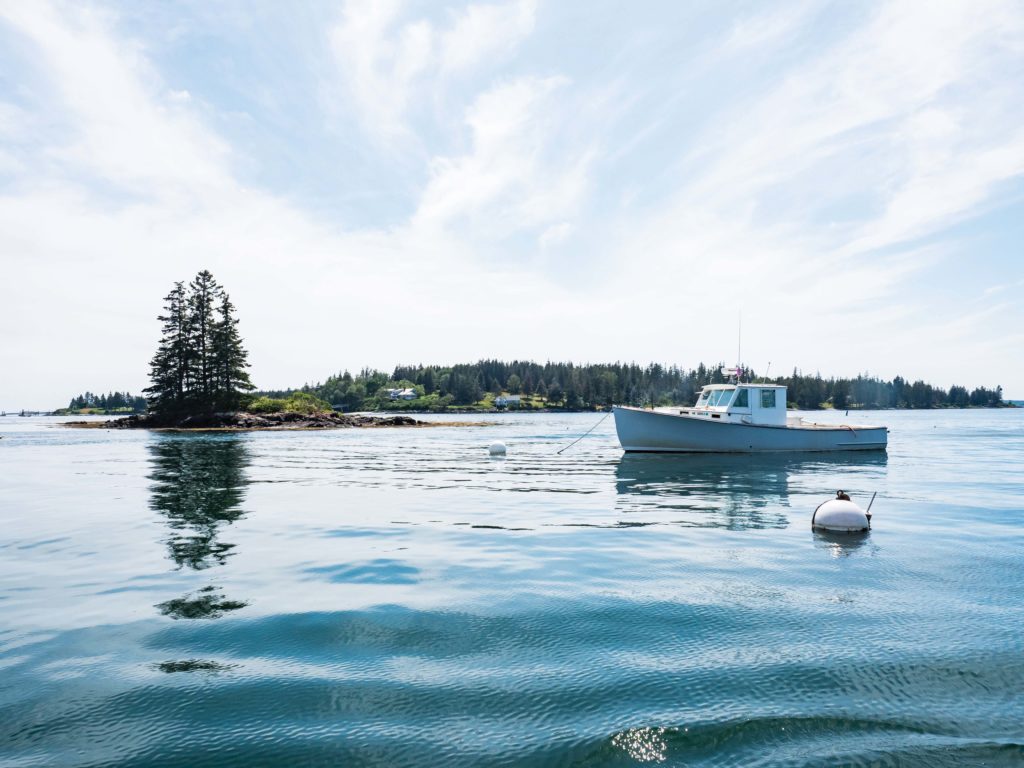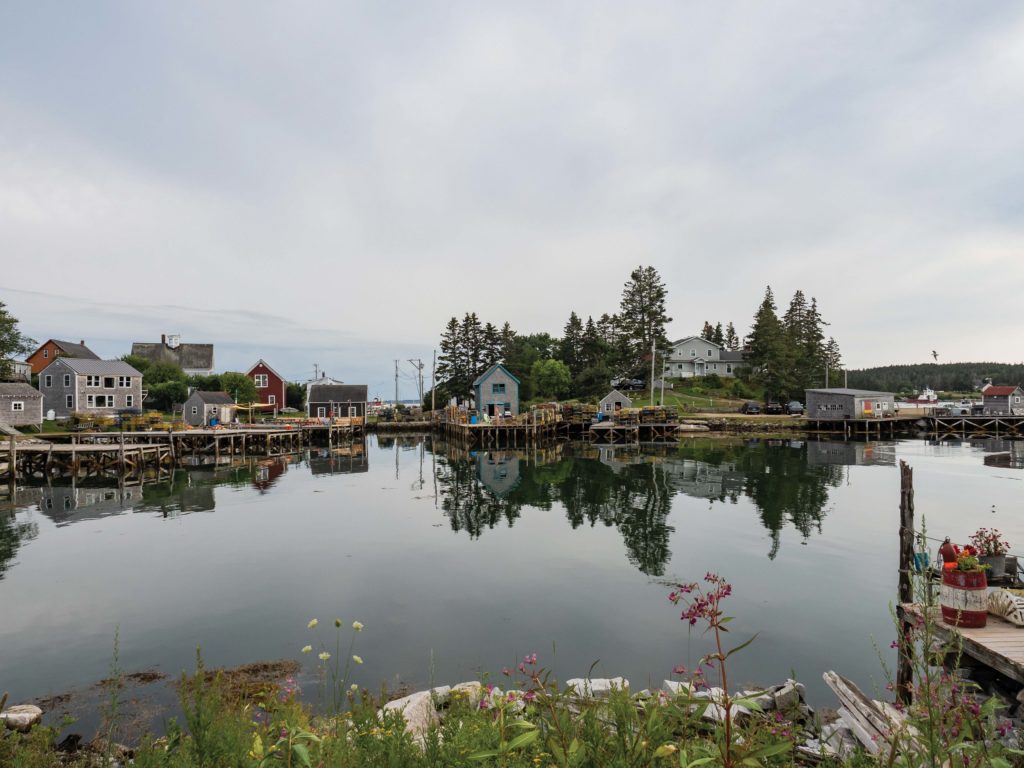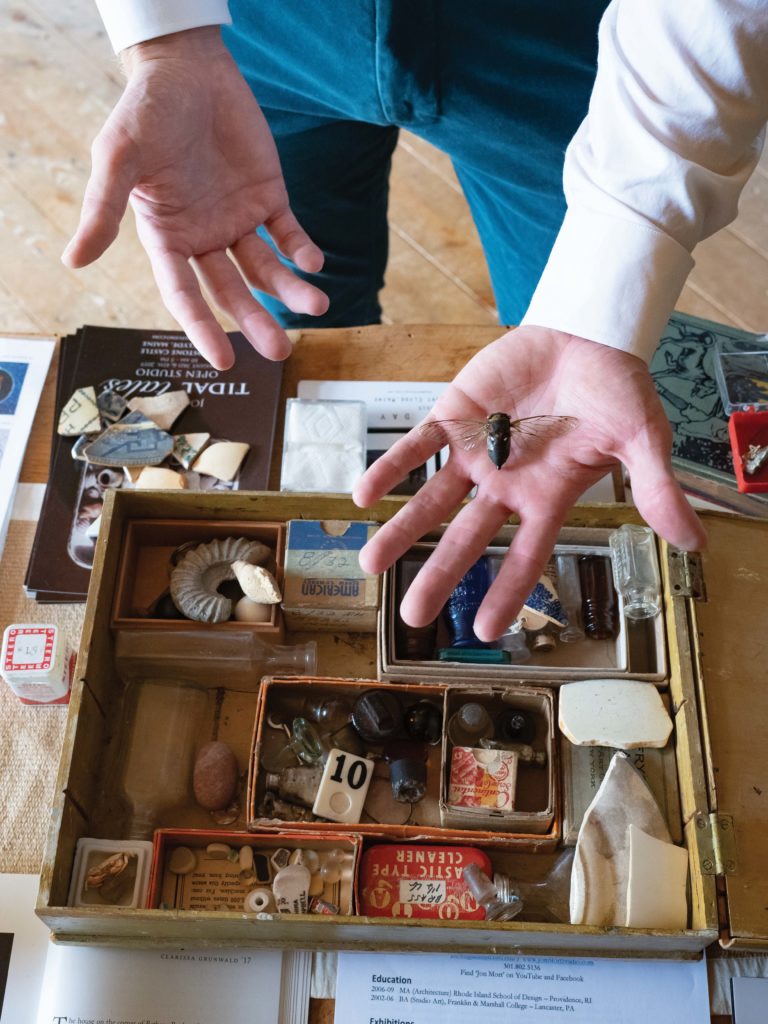Sea Art, Port Clyde
Lobster boats ply the harbor and cedar-shingled houses ring coves lined with storm-washed boulders and tumbled seaweed. For a couple of days in the fishing village of Port Clyde, we walk (and float) right into the scenery of sea paintings.

Sea Art,
Port Clyde
Lobster boats ply the harbor and cedar-shingled houses ring coves lined with storm-washed boulders and tumbled seaweed. For a couple of days in the fishing village of Port Clyde, we walk (and float) right into the scenery of sea paintings.
Issue: October 2019
By: Sandy Lang
Photography by: Peter Frank Edwards
Just after the captain and sternman pull in the last lobster trap, an eagle soars above the boat. And in the next moment, from a hillside along Port Clyde harbor, a woman steps past the wicker chairs on the porch of a white house and raises her arm in a quick wave.
It’s remarkable to be here, I think, but I also realize that in many ways, it’s an ordinary day on the southernmost end of the St. George peninsula jutting into Muscongus Bay between Bath and Rockland. Art and seafood have been integral to life through the twentieth century and today. The working waterfront is still ringed with lobster boats and docks. And while the Wyeth legacy continues, countless other artists have also been inspired to draw, paint, photograph, write, and sculpt at this water’s-edge outpost. In the village we find several galleries and pop-up shows, including works at the Port Clyde Art Gallery, an artists’ cooperative in the upstairs of the Barn Cafe next to the Seaside Inn, which overlooks the harbor on Cold Storage Road.

These small, saltwater moments grow larger in my mind when a local art history guide confirms that the house is Eight Bells, and the figure on shore is the same woman I’ve seen in iconic paintings—she with a strong-boned face, fair skin, and hair often in twin braids at her shoulders. It feels surreal to realize we’ve just gotten a glimpse of Helga Testorf, the longtime model and subject of more than 240 paintings and drawings done in secret in the 1970s and 1980s by Andrew Wyeth (1917-2009), who lived seasonally in Port Clyde and then Cushing, across the St. George River. (The works were kept secret even from their spouses, and when revealed in a flurry of magazine stories and gallery shows in the 1980s, the Helga series created a stir in the art world.)
In years past, photographer Peter Frank Edwards and I stopped briefly in Port Clyde when passing through to catch the ferry that shuttles to and from Monhegan Island. But this time we’re not joining the line of visitors waiting to board the 1940s-era Laura B to Monhegan. Instead, for a couple of days in this salty realm of artists and fishermen, we’re staying close by to explore.

We Drift Inn
On a sunny summer morning, we make our way to the St. George peninsula, turning from the coastal highway to follow Route 131 for about 15 miles until it ends at the wharves of Port Clyde, with an estimated population of about 280. The roadway leads past Thomaston, St. George, Tenants Harbor (the largest of the peninsula’s villages), and Martinsville along the way. Just before Port Clyde, a turnout leads to a tree-shaded parking lot and a peaceful crescent of sand and rock named Drift Inn Beach (the actual Drift Inn is long gone). Three teenagers have a stand-up paddleboard in the water, and there are families and couples wading into the shallow water or sitting in beach chairs. It looks to be a good spot for a picnic or people- watching, and a bold seagull walks right up to my bag when I set it down and sit for a few minutes on a sun-warmed boulder. On the walk back to the car, we’re already seeing painted works on display and for sale: beach scenes on postcard-sized canvases for $20.

The waterfront is home to Off the Dock Lobsters, seen here, and the Port Clyde Fishermen’s Cooperative. Fishing boats dock here to unload, and customers buy live lobsters, crab claws, and whole crabs. The colorful lobster sculptures for sale are made by lobsterman Dennis Cushman. 
Dinners served wharf-side at the Dip Net in Port Clyde focus on fresh seafood and local ingredients, such as this meal of lobster, steamer clams, corn, seaweed salad, and haddock tacos.
In a few minutes we’re on our way to a Wyeths by Water tour on a 42-foot lobster boat owned by Linda Bean, granddaughter of retail giant founder Leon Leonwood Bean. After meeting the boat and several other passengers at the wharf in front of the Port Clyde General Store, we’re soon motoring through the harbor. A harbor seal pops up, fishing, and Captain Dennis Leight checks several lobster traps. The water is remarkably calm and glassy as we venture up the St. George River to South Cushing for a water view from the perspective of Andrew Wyeth’s famous painting Christina’s World, and we can see the edges of the Olson family’s homestead.
“This river and the islands were basically their canvas,” says Rayette Hudon, who narrates the tour—the passengers wear headphones to hear her over the lobster boat’s engine—and works at the Wyeth Gallery in the village. While on the boat, she alternately points to specific landscapes and views on the shore, and then to the pages of a notebook with samples of the art created by three generations of Wyeths—N.C., Andrew, and Jamie. The art often depicts the very same places in view. The family began spending summers in Port Clyde in the 1920s when N.C. Wyeth purchased the home called Eight Bells, which he named in tribute to the painting by Winslow Homer, who also painted by the Maine shore (at Prouts Neck).

A view from the ferry wharf of the Dip Net and the Port Clyde General Store. 
Weathered shingles and lobster buoys are a common sight in Port Clyde.
Wharfside Dip
A sea kelp salad with ginger and sesame is on the menu at the Dip Net, open May to October, and we order that along with a fresh lobster, steamer clams, and haddock tacos. We skipped lunch and make the most of this early-evening feast in the open-air seating that gives us ocean breezes and views of lobster boats and sailboats from one of the tables on the backside of the Port Clyde General Store.
The restaurant is a separate business from the general store, which is also owned by Bean and has a small but decent wine selection behind the cashier’s check-out register. There’s also a gasoline pump right beside the entrance door for people who arrive in remote Port Clyde without much gas in the tank. (Count us in that crowd.) And just down the dock is the tiny Squid Ink Coffee, where most customers seem to take their drinks outside to the dock to stand or sit, the water views here drawing everyone in. After dinner we walk around the village and see some kids who say they’re fishing for pollock, and we happen on a show and reception at the Barbara Prey Projects gallery, where the artist known for her super-sized watercolors greets us warmly. After sunset, on this height-of-summer night, we sleep just uphill from the harbor in a white-painted room up two flights of stairs in the small Ocean House Hotel, built in the 1820s as a rooming house for mariners visiting the port.

In the barn studio where Jon and his artist father, Greg Mort, work each summer, Jon shows a preserved cicada from the natural and made objects that he collects and studies for use as subjects in his drawings. 
Jon Mort is one of the countless artists who paint, draw, and sculpt in Port Clyde—an artist roster that includes the Wyeth family. 
The nineteenth-century Marshall Point Light Station in Port Clyde, where the keeper’s house is open as a museum.
Lighthouse to Barn
The next morning has a fog-thick start. Only seagull cries cut through the gray, and I can’t see past the ferry wharf. The lobster boats that typically motor out before dawn must already be out and off their moorings. By car, we wind around the harbor to the Marshall Point Lighthouse Museum and look at historic pieces, including former lighthouse keepers’ gear and family photographs, a new barn just restored, and a collection of cans from decades of the fish canning industry on the peninsula. Before it burned in 1970, Port Clyde Sardines employed as many as 200 people in the herring pickling factory here. Aluminum cans from the factory, melted and distorted by the massive fire, are said to still wash up on beaches around Port Clyde.
Not far from the lighthouse, we turn onto an unpaved lane to visit the barn-style studio of Greg Mort and Jon Mort. Jon has just had a show in the summer studio, and he and his artist father, Greg, are getting ready for a joint show in November and December in Delaware. (Greg’s paintings are in many prominent collections, including those of the Smithsonian and the Portland Museum of Art.) A second generation artist, Jon is a collector of sea shells, cicadas and butterflies, vintage stamps, coins, and other objects that he keeps in boxes and bins to refer to as subjects in his colored pencil drawings. Exploring local beaches, woods, and islands on the family’s Boston Whaler boat—and looking toward the stars from Port Clyde into a clear, dark night sky—have been a consistent source of ideas and specific subjects to draw. His architecture-school training leads to clean lines and organization—he creates remarkably exacting representations, and even the signatures on his works are clear and legible. The subject of a recent piece is a small can filled with tiny seashells. It’s a mix of the manmade and what can be found in nature, and juxtaposing the two offers a human story of collecting and memory. The view outside his summertime workspace, lined with tall barn windows, is of a spruce woods. “The natural cycles of this place,” Jon says, give him space to work and inspiration.

An art hub in Port Clyde is the Barn Cafe at 5 Cold Storage Road, with a seasonally-open gathering place downstairs and the Port Clyde Art Gallery upstairs. 
A summer show of works by Jan Lipson and Rick Rockwell.
Old Salts, New Salts
We walk down Co-Op Road in the afternoon to the small shed that houses Off the Dock Lobsters, which sells lobsters brought in by about 20 local boats in the Port Clyde Fishermen’s Cooperative. The dock here is lined with outdoor sinks, work tables, buoys, buckets, and bins. A lobster boat is unloading its catch and the tide is low, so the boat and crew are below us.
Dennis Cushman on the Linda Lee looks up and calls out to us to ask if we’d like to see what he calls a “hard shedder.” This is what you want, he says, and lifts a lobster so it’s in reach. “It’s off the hard bottom, and it’s full of meat.”
Another lobsterman from the crew notes that Cushman is from a multi-generation fishing family in Port Clyde, and he also crafts lobster-shaped sculptures from lobster trap wire. Several are arranged on walls of the Off the Dock shed, and when I ask about them, Cushman explains: “I made some for Christmas presents, and the wife said, ‘You could sell those for money.’”

Jim Lee processing Jonah crabs. 
A family fishes from one of the docks around Port Clyde’s harbor. 
Dennis Cushman with a lobster.
If Cushman is one of the old salts, new salts on the St. George peninsula include Jim Lee, a former merchant marine and Alaska fisherman who captains a 1960 “lobster yacht” (not in the active fishing fleet), and he’s the new operator of Off the Dock Lobsters. Lee is removing claws from a bin of Jonah crabs when we arrive, and he explains that the co-op is beginning to market the crab claws more, along with the daily catch of lobsters, and occasional halibut brought in by the fishing boats. When we buy a lobster and a bag of crab claws, he asks if we need ice or seaweed for travel, but we’re not going far. The fresh seafood will be our dinner tonight.
When we leave Port Clyde, passing through the shingled village once more, I consider its comfortable appeal. The beauty in Port Clyde is what there is, and what there isn’t. No chain stores, no stoplights, but boats in motion between islands, and weathered wood houses, rocks, and fir trees, set against the water and sky—a working waterfront and fishing village scene to walk into, and sometimes, to paint.

